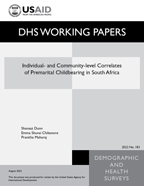There is no printed copy available to order.
Abstract:
In South Africa, there have been significant changes in childbearing among women. Most of these changes have been influenced by the steady increase in age of first marriage along with improvements in women’s education and participation in the labor force. For many women in South Africa, both young and old, premarital fertility remains an important topic of concern because it has important demographic, social, economic, and health implications for mothers and their children. Thus, the overall aim of this study is to examine the individual- and community-level correlates of premarital fertility among women age 25 to 49 in South Africa. Using data from the South African Demographic and Health Survey (SADHS) 2016, the study examines premarital fertility among a sample of women age 25 to 49 who have ever given birth and have ever been in a union (N = 3,008). In the study, 57.3% of births were premarital in comparison to 42.7% that occurred in a union. There were some statistically significant variables associated with premarital fertility in the bivariate analysis, such as age at first birth, age at first sex, education, and household wealth status. In the adjusted logistic regression, age at first birth and household wealth were significantly associated with premarital birth. Women who were older than age 18 when they had their first birth had lower odds of reporting a premarital birth in comparison to those who were younger than age 18 at the time of their first birth (OR = 0.4, 95% CI: 0.3–0.5; p < .05). In addition, women in the lower (second, middle, and fourth) wealth quintiles had approximately twice the odds of reporting a premarital birth compared to women from the highest wealth quintile. However, there were no statistically significant differences between the women in the lowest and highest wealth quintile. The findings of this study highlight important factors associated with premarital fertility among women age 25 to 49 in the South African context. Policies and interventions should address the correlates associated with premarital fertility as a step toward improving the socioeconomic circumstances of women and advancing gender equality.
 Individual- and Community-level Correlates of Premarital Childbearing in South Africa (PDF, 608K)
Individual- and Community-level Correlates of Premarital Childbearing in South Africa (PDF, 608K)
